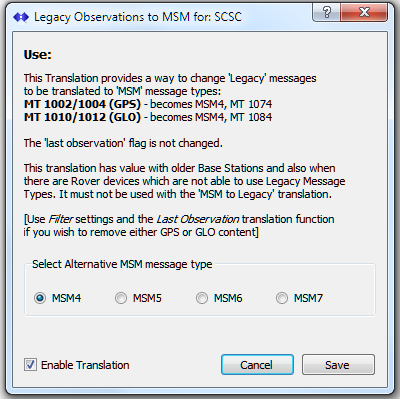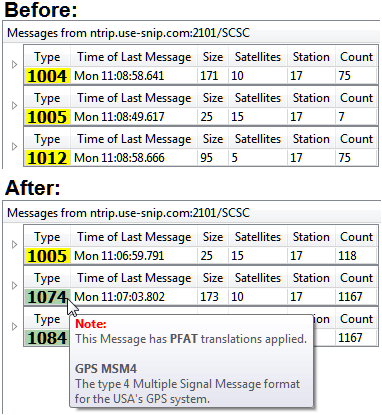The Legacy to MSM translation is used to translate older Legacy messages to newer MSM style message types (msm = multiple signals messages). This has value to network operators with an installed base of older Base Station GNSS devices which cannot produce MSM messages directly. Caster streams can be developed that overcome these limits. And these streams may be used with other GNSS Base Station sending MSM content in NEAR pools. RTCM SC-104 recommends that MSM and Legacy observations should not be combined in the same stream, and it is wasteful of wireless bandwidth.
In more detail: messages MT1002~1004 (for GPS) and MT1010~1012 (for GLO) are converted to the equivalent MSM message types selected during setup. That is, messages MT1074~1077 (GPS) and MT1084~1087 (GLO). Only GPS and GLO GNSS types are supported, as the other GNSS types do not have legacy equivalents. In general, only the MSM4 message would be used because the source Legacy messages lack extended precision of any Doppler information which is found in MSM5, 6, or 7.
Use
This translation consists of an on/off checkbox (“Enable Translation”) and a set of radio buttons to select which of four possible MSM style message types is to be output. The default message choice of “MSM4” should be used unless it is desired to create MSM5, 6, or 7 messages with empty data content where the Legacy source cannot provide it (such as Doppler data).

If the subject stream does not contain messages with suitable Legacy content, some informative warnings are presented and the checkbox is disabled.
A note about Loss of Lock Times. The loss of lock count is used in RTCM observation messages to convey the minimum interval of time since the last detected carrier loss occurred on a given signal. It is generally used by the rover device as a quality indication and when loss of lock occurs on a given signal the carrier wavelength ambiguity process must be repeated. In the MSM messages there are two definitions for loss of lock time, and in the Legacy message definitions there is a third. These three definitions vary in range and precision and were selected to conserve bit sizes in the messages. When translating from one message to another, mild truncation between these intervals occurs.
Example
Simply enable the translation on any Base Station stream sending GPS and/or GLO Legacy message content. You can see the resulting translation using stream tool tips or with the RTCM message viewer.

Note the tool tip showing that the GPS MT1004 has been translated to GPS MT1074. The green highlight color in the message numbering cells also serves to indicate that the message has had PFAT operations performed on it.
Hint: If both a Legacy and MSM stream will be provided from a Base Station, you may want to append the text “-MSM” to new MSM streams to help users identify the stream.
The reverse of this operation is provided by the translation called MSM to Legacy and is described in this article.
